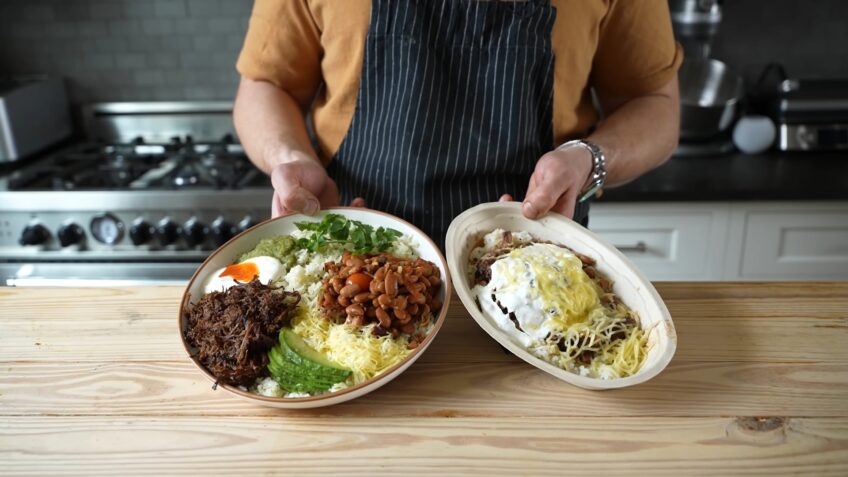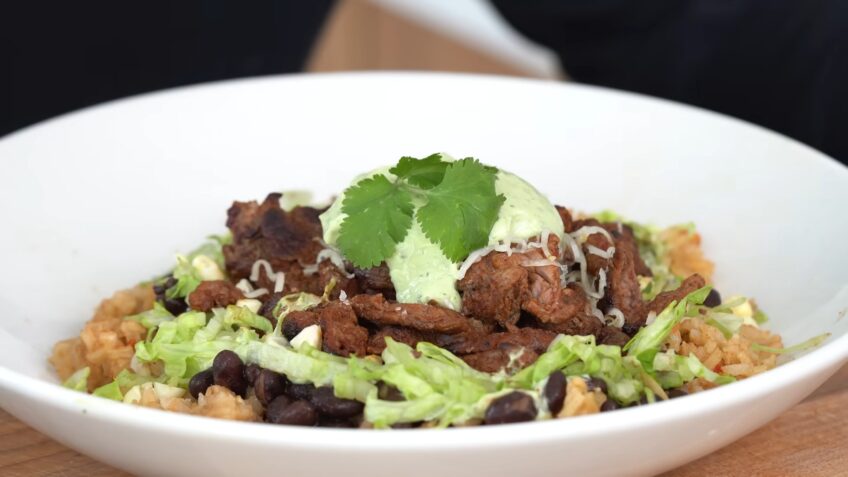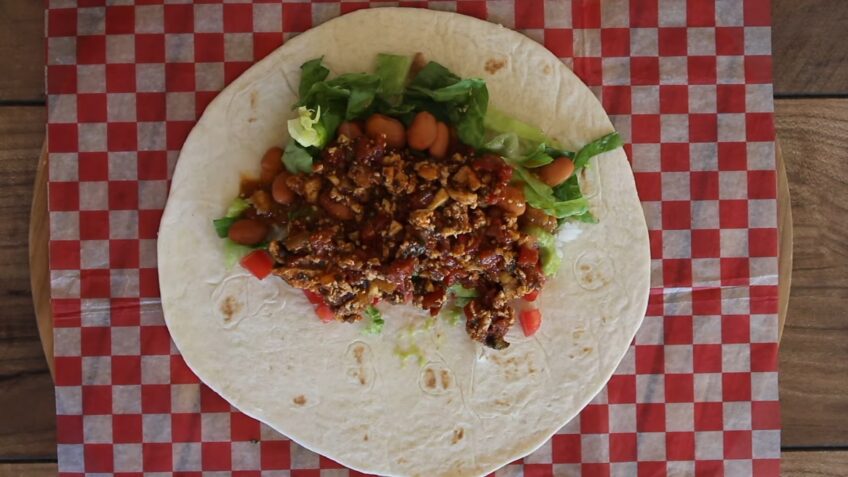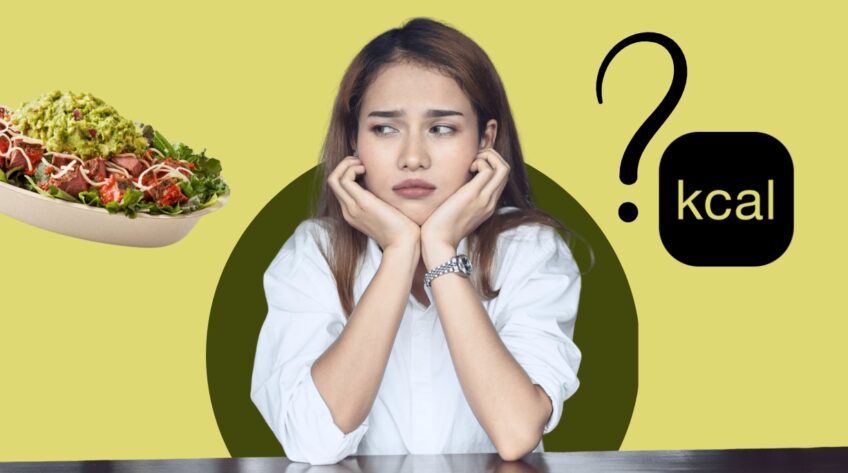Do you like Chipotle bowls? In this article, we delve into the world of Chipotle bowls, a popular choice for many seeking a quick, tasty, and seemingly healthy meal. But what lies beneath the delicious layers of these bowls? How do they manage to satiate our hunger so effectively? Let’s embark on this exploration, unraveling the caloric enigma that is the Chipotle bowl.
Why Chipotle Bowls Are So Filling

Chipotle bowls have a reputation for being incredibly satisfying. This satisfaction stems from the balance of macronutrients – proteins, carbohydrates, and fats – that work together to keep you feeling full. According to a study by the University of Washington, a meal that provides a balance of these nutrients can keep you satiated for longer periods, reducing the need for unnecessary snacking. The secret to the satiety of Chipotle bowls lies in their composition.
Each bowl is a symphony of ingredients that contribute to a balanced macronutrient profile. The protein from the meat or tofu, the carbohydrates from the rice and beans, and the fats from the cheese and guacamole all play a role in making these bowls a filling meal option. A typical Chipotle bowl contains around 600-700 calories, which is about a third of the recommended daily caloric intake for an average adult.
The Ingredients
Peeling back the layers of a Chipotle bowl, we find a variety of ingredients, each with its nutritional profile. The base layer, usually rice or lettuce, provides a significant portion of the bowl’s carbohydrates. A serving of white rice at Chipotle contains about 210 calories, while lettuce, a lighter option, contains only 5 calories per serving.
The next layer, the protein, is a major contributor to the bowl’s caloric content. A serving of chicken, the most popular protein choice, adds about 180 calories. Vegetarian options like sofritas or black beans contribute around 150 calories per serving. The protein not only adds to the caloric content but also aids in satiety, making you feel full for longer.
Portion Sizes
Portion size plays a significant role in the caloric content of a Chipotle bowl. A standard serving of each ingredient is carefully measured to ensure consistency. However, the actual caloric content can vary depending on the serving size. A study by the Journal of Public Health Nutrition found that portion sizes have been increasing over the years, leading to higher caloric intake.
In the case of Chipotle bowls, a larger serving of rice or protein can significantly increase the caloric content. For instance, an extra serving of white rice adds another 210 calories, while an extra serving of chicken adds 180 calories. Therefore, being mindful of portion sizes can help control the caloric content of your bowl.
Nutritional Benefits
Protein is a vital component of any meal, and Chipotle bowls are no exception. The protein in these bowls comes from a variety of sources, including chicken, steak, sofritas, and beans. According to the USDA, a serving of chicken at Chipotle provides about 32 grams of protein, while a serving of black beans provides about 8 grams.
Protein plays a crucial role in satiety. A study published in the American Journal of Clinical Nutrition found that high-protein meals lead to greater feelings of fullness. This means that the high protein content in Chipotle bowls can help you feel full and satisfied, reducing the likelihood of overeating.

Carbohydrates
Carbohydrates are another key component of Chipotle bowls. The primary sources of carbs in these bowls are rice and beans. A serving of white rice at Chipotle contains about 40 grams of carbohydrates, while a serving of black beans contains about 22 grams, according to the USDA. Carbohydrates provide the body with energy.
However, not all carbs are created equal. Complex carbohydrates, like those found in beans, are digested slowly, providing a steady release of energy and keeping you full for longer. On the other hand, simple carbohydrates, like those found in white rice, are digested quickly, leading to a rapid spike and fall in blood sugar levels.
Guacamole and Cheese
Fats, often misunderstood, are an essential part of a balanced diet. In Chipotle bowls, fats primarily come from guacamole and cheese. A serving of guacamole adds about 230 calories, while a serving of cheese contributes around 100 calories, according to Chipotle’s nutritional information.
Despite their high caloric content, these ingredients are rich in healthy fats. Guacamole, made from avocados, is high in monounsaturated fats, which are heart-healthy and can help lower bad cholesterol levels. Cheese, on the other hand, is a good source of both protein and calcium.
The Vegetarian and Vegan Options
For those following a vegetarian or vegan diet, Chipotle offers a variety of options. The sofritas, a tofu-based protein option, contain about 150 calories per serving. The vegetarian bowl, which includes sofritas, black beans, rice, and vegetables, totals around 535 calories, according to Chipotle’s nutritional guide. Vegan options are also available.
A vegan bowl, which excludes cheese and sour cream, contains around 460 calories. These options provide a lower-calorie alternative to the standard bowls, while still offering a balance of macronutrients.
Dressings, Sauces, and Salsas
The final layer of a Chipotle bowl often includes dressings, sauces, and salsas, which can significantly impact the bowl’s overall caloric content. The Chipotle honey vinaigrette, for example, adds 220 calories. The salsas, while lower in calories, can still add up. The tomato salsa adds about 25 calories, while the corn salsa adds around 80 calories.
While these additions can enhance the flavor of the bowl, they can also increase the caloric content. Therefore, it’s important to be mindful of these hidden calories when customizing your bowl.
Strategies for Lower-Calorie Chipotle Bowls

For those seeking a lower-calorie option, there are several modifications you can make to your Chipotle bowl. One strategy is to opt for a salad base instead of rice. By choosing lettuce over rice, you can save around 200 calories. Another strategy is to choose lean proteins like chicken or sofritas, which are lower in calories compared to options like carnitas or barbacoa. Additionally, consider limiting high-calorie additions like cheese and guacamole.
While these ingredients are rich in healthy fats, they can significantly increase the caloric content of your bowl. Instead, opt for fresh salsas, which are lower in calories and packed with flavor. By making these modifications, you can enjoy a Chipotle bowl that aligns with your health goals without sacrificing taste.
Tips for Achieving a Well-Rounded Meal
Achieving a well-rounded meal at Chipotle is all about balance. The key is to include a mix of proteins, carbohydrates, and fats in your bowl. Start with a base of rice or lettuce, add a protein source like chicken or sofritas, and include a serving of beans for additional protein and fiber.
For fats, consider adding a small amount of cheese or guacamole. While these ingredients are higher in calories, they provide healthy fats that are beneficial for heart health. Finally, top your bowl with fresh salsas for a burst of flavor and a dose of vegetables. By balancing these macronutrients, you can create a Chipotle bowl that is not only delicious but also nutritionally balanced.
Enjoying Chipotle Bowls in Moderation
Mindful eating is a powerful tool for maintaining a healthy relationship with food. It involves paying attention to your hunger and fullness cues, eating slowly, and savoring each bite. When enjoying a Chipotle bowl, take the time to appreciate the flavors and textures of each ingredient.
Remember, it’s not just about the calories – it’s about nourishing your body with wholesome, delicious food. While Chipotle bowls can be high in calories, they can still be part of a balanced diet when enjoyed in moderation. So the next time you’re at Chipotle, take a moment to eat mindfully, savoring each bite and appreciating the nourishment your bowl provides.
Final Thoughts
As we conclude our exploration, it’s clear that the caloric enigma of Chipotle bowls is a complex interplay of ingredients, portion sizes, and nutritional composition. These bowls, while delicious and satisfying, can vary greatly in caloric content based on your choices.
By understanding the nutritional impact of each ingredient, you can customize your bowl to fit your dietary needs and preferences. So the next time you find yourself in line at Chipotle, you’ll be equipped with the knowledge to make an informed decision. Bon appétit!

